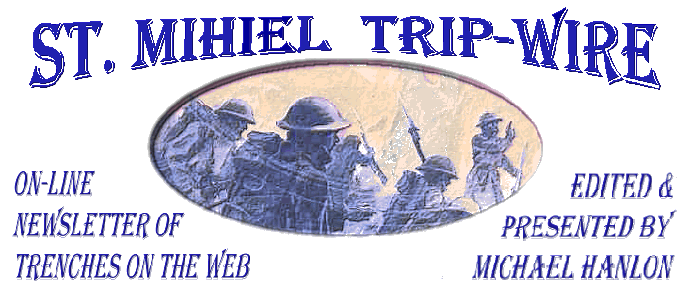
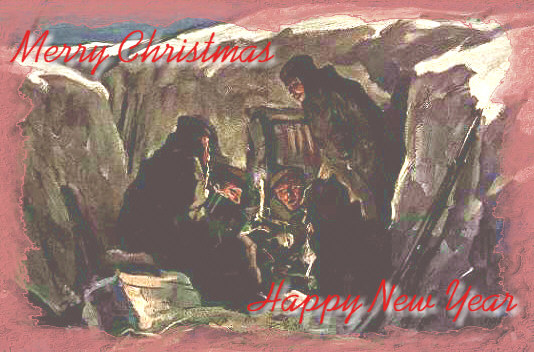
TRENCH REPORT: December 2006 brings a major event and a major announcement for the WWI Community.
THE EVENT: America's National World War I Museum will be opening on December 2nd at the Liberty Memorial in Kansas City. The Western Front Association, US Branch has organized one of their chapters around the Museum. In this issue of the Trip-Wire you will find links to their article on the opening and an announcement on their escorted tour of the Museum scheduled for December 9th. . .
THE ANNOUNCEMENT: In January I will begin publishing my new Magazine of the First World War: Over the Top. It will be an eight-page version presented in the same quality as last month's HMS Dreadnought Anniversary Supplement. (Download if you haven't seen it!) As I've mentioned previously this will be a subscription service, but the Trip-Wire will continue exactly as in the past as a free service. The new publication will meet other needs I've been asked about repeatedly over the years. It will allow me to present in-depth articles from major writers and authorities and will also allow you to print out a hard copy for your own archives. On the last page of this issue below, you will find full information on Over the Top. (link) Please take a look. MH
This Month's Internet Feature
New Styles of Warfare:
The Somme & Verdun + 90

Tommies in the Trenches
Iraq - Quite Recently
Trench Warfare from the Somme to the 21st Century
Principles of War in the 21st Century [pdf file]
New Styles in Warfare
Genghis John Boyd: Guru of New Conflict
The Latest Military Revolution

The Dead Man's Penny
Commonwealth Memorial Plaque (article)
New at the Websites of the Great War Society and Our Friends
Click on Title to Access
|
At Great War Society Sites
Two from Member David Homsher:
And more:
At the WFA-USA
|

Mémorial Américain de la Pointe de Grave
246 ft Lighthouse Built Near Mouth of Mouth of Gironde River From Whence Lafayette Departed for America in 1777 & Near Landing Site of First Doughboys in 1917; Dedicated 1938, Destroyed By German Army 1942

Lt. Eric Poole, despite substantial medical evidence he suffered from Shell Shock, was the first British Officer executed for desertion in the Great War December 10, 1916.
(link)
|

Memorable Event
|
Bucharest Falls
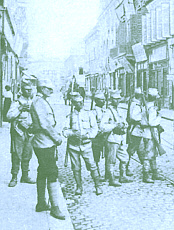
Defenders of Bucharest
December 5, 1916
Click on Image for More Information
|
|
GREAT WAR 2006 EVENT CALENDAR
|
Verdun and Somme
90th Commemorative Events
Comprehensive Double Calendar
Scheduled Throughout 2006 (link)
|
Liberty Memorial & National WWI Museum
Kansas City, MO
Reopening Ceremony
December 2nd, 11am (details)
WFA-USA Guided Tour
December 9, 1:30pm
Email to Save a Spot (email)
|
Send additions/corrections:
Email Response
|
Oh, What a Lovely War! is now out on DVD in widescreen (16:9) format. The only complaint might be that it's mono but considering its year of production (1969) that's not unusual.
Check out: NPR's Living History Project on Last Surviving Vets
Ghosts of the Great War: Aviation in World War One featuring the spectacular photographs of Philip Makanna has recently been published by Ghosts, San Francisco. (website). Phil's been photographing airplanes for over three decades and this is his first book on WWI. He was able to photograph 18 different WWI aircraft of The Aeroplane Collection. Javier Arango the owner of The Aeroplane Collection wrote the text describing each aircraft, their history and flight characteristics. One of annual Ghosts 2007 Calendar features 12 aircraft selected from the 160 color photographs from his book. You can also buy a CD at the Ghosts website that includes engine starts, taxiing, takeoffs, flybys of five aircraft from the collection. AM
Preserving the USS Texas
According to the October 2006 edition of Naval History, The Battleship Texas Foundation is seeking a $20 million restoration of the battleship Texas (BB-35). The Texas was laid down in 1911 and launched in 1914, one of the final class of coal-burning American dreadnoughts powered by reciprocating engines. In over 30 years of service, the Texas supported the 1914 landings at Vera Cruz, formed part of Admiral Hugh Rodman's battle squadron attached to the Grand Fleet at Scapa Flow in 1917-18, was at the surrender of the German High Seas Fleet in 1918, and won five battle stars in World War Two before being decommissioned in 1948. She is the last surviving dreadnought of WWI vintage.
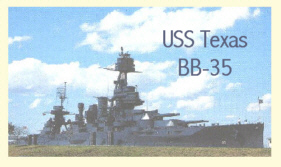
The Texas is now moored off the Houston ship channel near the San Jacinto monument at Buffalo Bayou and is open to the public. She was partially refurbished in 1989 at a cost of $15 million. One concept for the planned future preservation calls for the building of a graving dock at her present mooring with work on the ship to be completed by the 100 anniversary of her launching in 2011. L.S.

Harry Lauder's End of the Road
Ev'ry road thro' life is a long,
long road,
Fill'd with joys and sorrows too,
As you journey on how your heart
will yearn,
For the things most dear to you.
With wealth and love 'tis so
But onward we must go-
Chorus
Keep right on to the end of the road,
keep right on to the end,
Tho' the way be long, let
your heart be strong,
Keep right on round the bend.
Tho' you're tired and weary still journey on,
till you come to your happy abode,
Where all you love you've been dreaming of
will be there at the end of the road.
Composed shortly after Sir Harry's son John was killed at Poziers, December 1916.
|
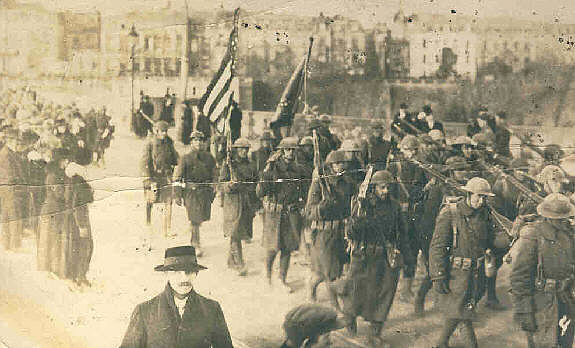
American Occupation Troops Arrive in Luxembourg, November 1918
|
|
Page Two
|
Ernest Charles Pusey, Florida's only living World War One veteran, has died. The onetime Michigan auto worker was 111 when he died on November 19th. He served on the Battleship USS Wyoming. (link)
Maurice Floquet, 111, who had been France's oldest living World War I veteran, died Friday at his home in Montauroux in southern France, an association of veterans said. With Floquet's death, only four French veterans of the Great War are still alive.(link)
Wikipedia has reported that Italy's oldest female veteran, Antonia De Bettin
Casanova 105, has passed away, but no news stories have appeared on this.
|
One of the Bravest and Best:
Corentin Carré
By Christina Holstein
Visitors to Verdun who feel that they have seen the sights and wish to visit the wider area may like to spend a day in the open, rolling countryside to the south of Verdun, visiting such places as Nixéville or Landrecourt, which - sleepy and forgotten today - swarmed with men during the battle of Verdun. To my mind the most pleasant way of visiting this area is to drive along the Voie Sacrée, or Sacred Way. This is the great supply and evacuation route that saved Verdun at the beginning of the battle and worked nonstop throughout all the months of war. There are, of course, many military cemeteries in the area and in one of them lies Corentin Carré, the youngest French pilot of the Great War and possibly one of the youngest on the Western Front.

Corentin Carré |
Among the men who rushed to volunteer when war broke out, Corentin Carré holds a special place. Born in Le Faouët, Brittany, France, on 9 February 1900, Corentin was 14 when war broke out. When his father was mobilised in August 1914, he tried to persuade the local authorities to let him sign up under the name of his half-brother. When this was refused, he took himself off to another part of France where he was unknown and signed up in April 1915 under the name of Auguste Duthoy, a native of a town in the Ardennes region which was then under German occupation. This made it impossible to check whether the name was correct and Corentin was posted, first, to the 41st Infantry and then the 410th Infantry, which had just been formed. After training, he was sent to the front in the Champagne sector in October 1915.
It was the start of an extraordinary career. Beginning as a private soldier, Corentin Carré, known as "le petit poilu", was promoted to corporal in February 1916. In June 1916 he was wounded. He was made a sergeant later the same month and, in November 1916, following various courageous exploits, he was cited in army orders and received the Croix de Guerre.
By December 1916, however, Corentin Carré's conscience had got the better of him and he wrote to his colonel to ask to sign on again under his real name, saying that he now had his father's authorisation to do so. He was allowed to do so, although he temporarily lost the promotion to adjutant that - at 16 years and 10 months - he had already received. He soon recovered his rank and in June 1917 was once again cited in army orders.
But by now Corentin had other ideas: he wished to become a pilot. He began training on July 1917, received his pilot's licence in October of the same year and in December was posted to S.O. 229 squadron, which was stationed at Lemmes - another little town on the famous Voie Sacrée. This squadron carried out photographic missions and artillery observation.
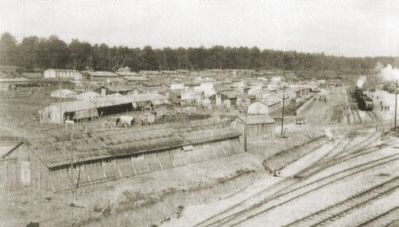
Hospital Complex at Souilly
On 19 March 1918 Corentin was carrying out an observation mission when he ran into trouble. According to the official version, his plane was attacked by three enemy aircraft but no German plane appears to have claimed the victory and it is possible that his plane was hit by anti-aircraft fire. He managed to bring it down and was taken, badly wounded, to hospital at Souilly, where he died on 22 March 1918. He had just turned 18.
Corentin Carré was at first buried at Souilly but was subsequently reburied in plot 1510 in the military cemetery at Rembercourt-aux-Pots, Meuse, France. A monument to the famous "little poilu" also stands today in the centre of his home town of Le Faouët.

Carré's Cemetery Cross and Hometown Monument
If you decide to drive south on the Voie Sacrée, spare a thought for this extraordinary young man. Turn west at Chaumont-sur-Aire and take the little road to Rembercourt. It is only a tiny place. The massive fortified church, a witness to the former rivalry between the Dukes of Lorraine and Bar, stands guard over a village composed of a café, a few houses, some farms and two military cemeteries. Far from his native Brittany, Corentin Carré, his spectacular career now largely forgotten, lies at rest with few visitors and only the larks for company. He was one of France's youngest and finest young men; who knows what he might have achieved?
|

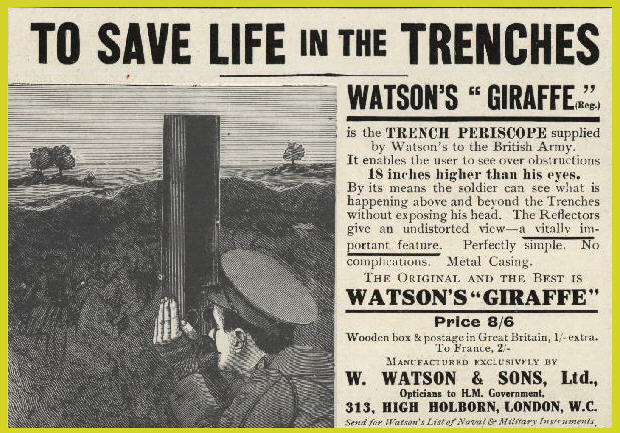
War-Time Advertisement
Click Here to Visit War in a Different Light
|
Verdun
December 1916:
End Game & Today
|

|
The Somme
December 1916:
Review
|
The end: On December 15th a further French attack pushed the front lines a further
two miles beyond the Forts and Verdun was safe. It was nearly one year since Falkenhayn had gained the Kaiser's approval to the battle. The official casualty figures are 373,000 French and 330,000 German.
These include wounded and missing, but are probably too low. In comparison with the Somme, these official figures are approximately half of that battle which equate to some 1,370,000, although the density of dead per acre was greater at Verdun than any other battlefield of that war. On December 27th Joffre was promoted to the status of a Marshal of France and Nivelle took over, buoyed by his successes at Verdun.
Later: In 1917 the Nivelle Offensive ended in the "acts of collective indiscipline"
by the French Army which is a polite way of saying "mutiny". They led to the removal of Nivelle and the promotion of Petain to be Supremo. He inherited an utterly disillusioned army, bereft of national pride, with a disbelief in its own management structure. By herculanean efforts he restored the Army's morale, improving beyond measure the soldiers existing conditions, and promised that no more wasteful assaults would be imposed unless all was well organized beforehand. He kept his word.
Around Verdun further small successful French assaults were made on both banks of the River
Meuse, and the area quieted down to a "normal" level. From mid 1917, the Americans began to arrive in France and they moved into quiet French Army sectors to learn the ropes. Eventually, they were instructed to organize themselves for what became known as the Meuse-Argonne offensive. They were in place and ready to go at dawn on September 26th 1918. Their jump-off points to the east of the Argonne Forest and on the west side of the Verdun battlefield adjacent to the River Meuse were the front lines previously held by the French Army in that same month. These were near the original lines from which
the German assault came on that far away day in February 1916. By November 11th 1918 halted in the original German rear areas of 1916. And it was all over. The lines were more or less back in their original position after the death or mutilation of maybe 1,000,000 men. Verdun continued below:
|
Current statistics quote the following figures:
The Somme cost 480,000 British, 210,000 French and (possibly) 680,000 German casualties, a total of 1,370,000 men. Approximately three men in ten were dead, about 400,000 in total.
Another 400,000 men, given their grievous injuries, possibly wished they were dead.
And the remainder were patched up and soldiered on.
The ground gained was minuscule given the scale of the Western Front. Was it worth the effort, and the deaths, and the waste?
Certainly it relieved German pressure on the French at Verdun and this was a factor in the decision to build and retreat to, the Hindenburg Line.
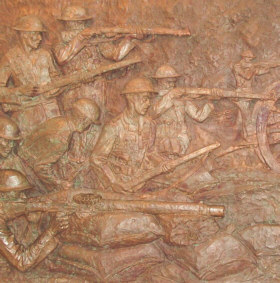
Detail South African Memorial
Delville Wood, Somme Battlefield
Present day historians believe it was, pointing to the military logic of the retreat.
Certainly the German casualties were becoming irreplaceable, but then so were the French and British losses. By 1918, the Germans were calling up 16 year olds for military service. The British and French never had to call up the extreme youth of their countries. So maybe The Somme was a success because within two years German manpower losses were a factor in their surrender.
If nothing else, the French could now be assured that the British forces would now involved to the bitter end.
Honour was satisfied
|
Verdun 2006: After the war the battlefield was never properly cleared of either the dead
or munitions and much of it was not returned to agriculture. Today Fort Douaumont,
Fort Vaux and Fleury Memorial Museum are open to the public, as is the vast Ossuary,
which contains the bones of, it is said, 130,000 men. The battlefield returned to
nature and remains to this day a wilderness of shell holes, trenches buried in vast,
gloomy forests, bones, unexploded ammunition, collapsing dugouts and the ruins of
hundreds of concrete structures, all of which could tell stories of bravery and
horror. If only they could speak.
In 2007 Tony Noyes Will Continue His Battle Diary Following the 1917 Campaign:
Nivelle Offensive, Arras, Messines, Passchendaele, Cambrai
If you are travelling to Europe and would like to visit these fields of memory for a detailed tour, please contact experienced guides Tony Noyes or Christina Holstein at Back to the Front
|
|

|
Our Little Token
1914
From Kimball Worcester, GWS Member
|
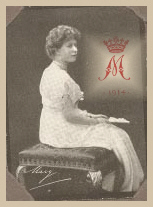
Princess Mary |
The first winter of the Great War saw two events that sustain one's hope in the potential for good even in times of dire conflict. One event was the spontaneous Christmas truce on the western front, primarily between British and German forces. The other was the spontaneous generosity of a 17-year old girl, Princess Mary, only daughter of King George V and Queen Mary. Her intention was to provide a Christmas gift for every person serving in the King's uniform, both abroad and on the home front. Her wish was fulfilled to an astounding degree and created one of the most touching mementos of the war.
Princess Mary's Christmas Gift Fund was announced on 15 October 1914. The Princess had wanted to underwrite it herself from her allowance, but it was decided by the inaugural committee, headed by the Duke of Devonshire, that a public subscription was the better source for funding. The response was enormously positive and generous. Ultimately 200,000 Pounds were raised by a nation eager to respond to the Princess' plea:
"I want you now to help me to send a Christmas present from the whole of the nation to every sailor afloat and every soldier at the front. I am sure that we should all be happier to feel that we had helped to send our little token of love and sympathy on Christmas morning, something that would be useful and of permanent value, and the making of which may be the means of providing employment in trades adversely affected by the war ... Please will you help me?" [1]

The Gift Box
The gift itself was a brass box, a tin with a hinged lid that measures 5" x 3 3/8" x 1 1/8". The lid bears a left profile portrait of the Princess, with her initial "M" on either side of the portrait. The seven Allies of the time are represented: embossed at the corners are Belgium, Japan, Montenegro, and Servia, and at the sides are France and Russia. "Imperium Britannicum" holds place of honor above Princess Mary's portrait, and "Christmas 1914" balances the center beneath her portrait. Within the box were several gifts that were distributed thus:
- Smokers received tobacco, a packet of cigarettes, a tinder, and a pipe; a photo of Princess Mary and a Christmas card from her.
- Non-smokers received a bullet pencil in a .303 cartridge, the photo and Christmas card, a khaki writing case, and a packet of acid tablets.
- Nurses received chocolates in their box, along with the photo and card.
- The various Indian servicemen received gifts in accordance with their dietary and/or religious observances, often sweets and spices instead of tobacco.
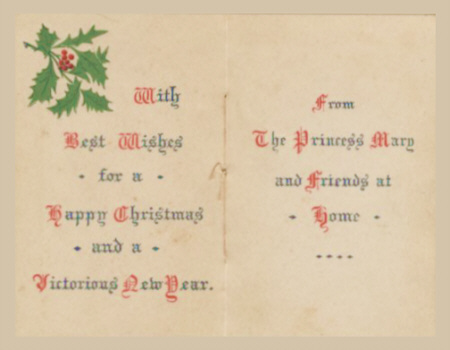
Accompanying Card
By Christmas of 1914, approximately 355,000 boxes had been distributed. Given the extensive fronts across the globe, it took well into 1916 to distribute all the boxes to those entitled to them; during that time war widows were included in the recipients. Ultimately, 2.5 million boxes were made, filled and given out. Many were carefully sent home from the front as keepsakes.
Princess Mary continued her connection with the armed services throughout her life (1897-1965), becoming colonel-in-chief of the Royal Scots (1918) and of the Royal Signal Corps (1935) in addition to several Commonwealth corps and regiments [2]. The legacy of the Princess Mary box is a genuine testament to her spirit of public service.
Notes:
1. Imperial War Museum. "Princess Mary's Gift to the Troops, Christmas 1914." November 18, 2006. (link)
2. Wikipedia. "Mary, Princess Royal and Countess of Harewood." November 18, 2006. (link)
|
|
Page Three
|
 |
Tea With Niall
Editor Mike Hanlon Chats With
Historian Niall Ferguson
|
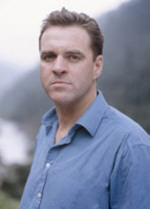
Niall Ferguson |
Provocative and prolific historian Niall Ferguson makes an annual autumn visit to the Hoover Institution at Stanford University. His two weeks are always jammed, but this year--between the filming of a documentary interview and a dinner with old friends in San Francisco--he was kind enough to spare an hour for me and the readers of the Trip-Wire. On the last day of this year's especially brilliant version of the Bay Area's renowned Indian summer, we sat down together for tea and biscuits at the outdoor Moonbeam Cafe on the Stanford campus.
I found him affable, open to various views & ideas, and able to look at any issue from several different angles, political and economic, or in the military sphere from the private's and lieutenant's viewpoints as well as the general's. His ideas started flowing by me so quickly, though, I soon stopped taking notes and just listened, later reconstructing in my car what I had heard. Here are some of the things I picked up:
- He is highly concerned about the lack of historical awareness in America, not only in the general population, but also among our policy makers. [More on this below.]
- Although his interests are varied, he is still reading and encouraging a lot of fresh research on the Great War. We talked about the work of one of his students, Alexander Watson, who has explored the role of the junior officer cadre in the German army in maintaining morale in the army even when the end was near. Watson has a forthcoming book on the topic of morale on the Western Front. Niall's own next thrust will be in the biographical sphere. He will be writing a volume on the banker Siegmund Warburg, to be followed by one on Henry Kissinger.
- He enjoyed hearing my report about how the World War I community in the States had responded to his writings, especially Pity of War, which was both highly praised for its unique approach and targeted as "revisionism" by some. He laughed after I explained why one of our members -- reacting to Ferguson's use of "counterfactual history" -- had called him the "Harry Turtledove of REAL Historians". [Turtledove writes in the alternative-history genre of science fiction, including a popular WWI series.]
- Speaking of counterfactual history, in his latest book, War of the World, he speculates that had America NOT entered the war militarily, the Entente would still have prevailed given the substantial financial investment the U.S. would have been compelled to make to protect her interests. In a mini-debate, we agreed that by the end of 1917 Germany was winning the Great War, and that their Spring Offensives subsequently exhausted the German army and people. We differed on whether the Ludendorff attacks would have been necessary for Germany without the AEF beginning to arrive, providing fresh and unlimited reinforcements for Britain and France: "No AEF » » No German Offensives » » No German Collapse » » Prospects of an Entente Victory, Therefore, Dubious," being my line of reasoning.
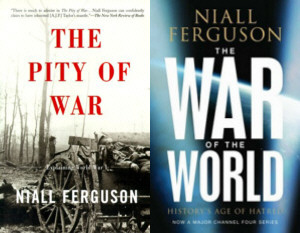
As our time drew short, I asked my "big" question: "For today's War on Terrorism, what is the biggest lesson that America's leaders can take from the First World War?"
Niall's answer was surprising and intriguing. He believes America needs to improve her approach to making National Strategic and Policy Decisions. He cited Germany's decision-making preceding the July Crisis of 1914 to the End Game in November 1918 as a case study in how not to go about this. As we walked back to his office at the Hoover Memorial, I was able to jot down some recommended readings for anyone who would like to pursue this topic or to mail the list to their elected officials:
- The writings of Stig Förster, much of which is still only available in German, were strongly recommended. As a coeditor, though, Förster included some relevant commentary translated into English in Great War, Total War: Combat and Mobilization on the Western Front, 1914-1918.
Also:
- The First World War: Germany and Austria-Hungary 1914-1918 by Holger H. Herwig
- War of Illusions: German Policies from 1911 to 1914 and Germany's Aims in the First World War by Fritz Fischer
All in all, it was a most productive tea on a pleasant afternoon.
|
|
World War I Headlines
in the
21st Century
|
|
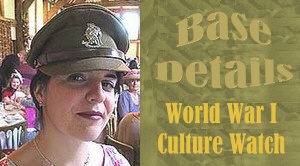 |
The War of Games
Part One:
By Dr. Esther MacCallum-Stewart
|
In my next three articles I will be looking at the representation of the First World War in computer games. An odd subject? Well, not really. Games are increasingly part of our culture and recent studies about them have recognised the part they have to play in constructing our cultural identity. So many people are exposed to, and enjoy games now, that to dismiss the part that historically based games play in informing readers is unwise.

Knights of the Sky
A Representative WWI Game
To disabuse some myths about games (only spotty teenagers play them, they induce violent behavior, they are bad for you), please see Henry Jenkins' wonderful 'Eight Myths about Video Games Debunked'. (link) It is not my intent to rehash old arguments, but to present a critical perspective. That out the way, let us turn to the First World War in these games.
World War One is not a popular subject in wargames, probably because of it's mythological connotations - mud, blood, futility and hopelessly inadequate generals. The First World War is not a heroic war, and it is perceived to have been mismanaged - both of these assertions rule out the premise for many games where you play the hero (in a first person shooter or real time strategy game), or a commanding general (in a turn-based strategy game). Conversely, World War Two is a very popular theme for games, thus somewhat eliding the need for earlier counterparts. Thus the games which have existed try to do three things:
1. Heroic events only please!
This is a typical act of displacement - take the more heroically presented acts of warfare and make them look good in games. The perceived romanticism of the war in the air makes it the most common topic for games about the First World War, with old classics such as The Red Baron (1980) (the first first-person shooter), Sopwith (1984) and Knights of the Sky (1990) all putting the player in charge of a plane (or planes) in order to defeat the enemy.
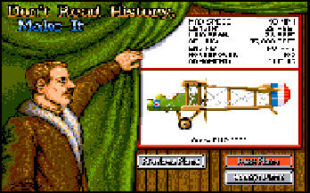
A Jolly Good Show in Knights of the Sky
(The caption upper-left reads 'Don't Read History. Make It')
2. Managing a World
World War One is part of the bigger picture. Many management games, such as the world building game Civilisation (1991-2005) games, or Victoria (2003) set you as the overlord of a world, responsible for its care and development. Within this, various historical 'events' are set to challenge the player as they develop throughout history, with some settings more historical than others - for example in Civilisation II it is possible to start managing your world at the beginning of the Twentieth Century, and the opposing sides will act in accordance with historical events.
3. 'Mods'
'Modding' is the term used for a game that uses the engine and source code of one game to create another. The most famous example of this is Counter-Strike (1999) and America's Army (2002), which were made from the Half-Life engine. Counter-Strike also converted a fantasy warfare game to a semi-historical one (instead of shooting monsters, the player now shot 'terrorists' or 'counter-terrorists'). Mods that included events from WWII were quickly released, however several First World War 'skins' exist, for the games including The Trenches (2003)
So, although Great War games exist, they aren't particularly common, especially when compared with the huge amounts of World War Two games like the Medal of Honor series. Next month I will look at how the First World War's iconography means that Sensible Software's Cannon Fodder (1993) caused such controversy
Dr. Esther MacCallum-Stewart is a researcher at the University of Sussex and runs our favorite First World War weblog Break of Day in the Trenches.
Click on the icon below to visit her site.

|
|
 |
The Roaring Twenties
By Andrew Melomet
|
In June 1938 Mark Hellinger sold Warner Brother Studio a story treatment "The World Moves On" for $10,000. Hellinger, a New York City newspaperman, based his story and characters on actual people he had known as a crime reporter: Larry Fay a notorious bootlegger and speakeasy operator and "Texas" Guinan, a speakeasy proprietress. Larry Fay was also the model for Jay Gatsby of "The Great Gatsby" by F. Scott Fitzgerald. Eleven screenwriters would eventually work on turning Hellinger's treatment into a screenplay. Only three would receive screen credits: Jerry Wald, Richard Macauley and Robert Rossen.

Scenes from The Roaring Twenties
The director, Raoul Walsh (1887-1980), was a last minute replacement for Anatole Litvak. Walsh had started directing with D.W. Griffith in 1912 and had headed a unit sent to Mexico to make a feature film on General Pancho Villa, The Life of General Villa (1912). He directed the first feature-length gangster film in 1915, The Regeneration. During World War One, Walsh was commissioned a second lieutenant in the Army Signal Corps. He worked in the United States, editing the documentary footage shot at the front. He was discharged with the rank of First Lieutenant and received a commendation from the War Department, signed by President Wilson. Walsh directed What Price Glory? (1926) based on the play by Laurence Stallings.
The story introduces us to three solders in April 1918 and follows through three eras in U.S. history; wartime, the speakeasy twenties and the post-prohibition thirties. Garage mechanic James Cagney, saloon keeper Humphrey Bogart and lawyer Jeffrey Lynn are the soldiers who meet on the battlefield by sharing the same shell hole. Taxi driver Frank McHugh is Cagney's best friend back home. Singer Priscilla Lane is the girl Cagney loves but who loves Lynn. And Gladys George is the speakeasy hostess who is in love with Bogart. Cagney is among the group of U.S. soldiers who return last from Europe after policing the Rhineland. The promise of his old job still waiting for him is broken. He becomes a bootlegger. He loses the girl to Lynn and his money due to the repeal of Prohibition and the Wall Street crash. After final confrontation with Bogart to protect Lane and Lynn, Cagney has one of the finest death scenes in movie history. When Walsh was once asked why it took so long for Cagney to die; he replied "It's always hard to kill an actor." Cagney got a National Board of Review award for Best Actor. The Roaring Twenties would be Cagney's last gangster film for 10 years, until 1949's White Heat, also directed by Raoul Walsh

DVD Cover |
The pacifist themes found in many 1930s film are in The Roaring Twenties: the cruel futility of war, war profiteering, post-war indifference to veterans, and the return of the "forgotten men." Walsh, in his first picture for Warner Brothers, created an American epic of social history. The opening symbolic montage sequence done in a quasi-March of Time newsreel fashion indicates that the life of the protagonist as something that was possible only under the chaotic social conditions that existed between the end of the Great War and the New Deal. The narrator links FDR, current "acquisitive power madmen" (Hitler and Mussolini), the seizing of Czechoslovakia by the Nazis with the signing of the peace treaty at Versailles and the rise of gangsters in the twenties. There's a definite implication that just as the First World War and Prohibition made criminals of many Americans; the peace allowed political gangsters to flourish overseas.
One of Byron Haskin's earliest special effects credits is for The Roaring Twenties. Edwin DuPar and Haskin worked on the incredible effects used in the various montage sequences. My earlier column on Byron Haskin is accessible in the Trip-Wire archives. The primary montage director was Don Siegel, who would go on to full-time directing starting with The Verdict in 1946. The montage sequences also appear in the documentary, Brother, Can You Spare A Dime? (1974).
The Roaring Twenties premiered in New York City in November 1939. The Fighting 69th premiered in January 1940 and Sergeant York in July 1941. Isolationist Senator Gerald Nye considered these films as being part of 'the foreign policy of Hollywood." Hollywood was leading the way from isolation to involvement long before the United Stated entered the Second World War in December 1941.
The Roaring Twenties was rejected for play dates in some Canadian provinces because they felt it "was a slander on the authorities in their regulation of returned soldiers." When the film was shown in Soviet cinemas is re-titled "The Fate of a Soldier in America."
The Roaring Twenties is available on DVD from Warner Brothers.
Andrew Melomet, Proprietor of Andy's Nickelodeon will answer your Great War film or video inquiry. He is also soliciting your recommendations for the WWI Filmography he is compiling for our readers. Just click HERE.
|
|
|
Something New for Our Readers
|
Announcing a New Publication
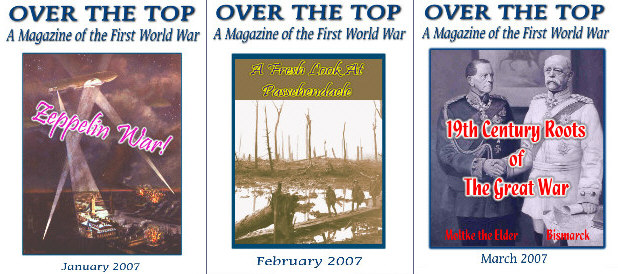
Our First Three Issues
All About Over the Top
- Each Issue: 8 pages, Full-Color, 8 1/2 x 11 in., in PDF format, published monthly. Downloaded from the web using your own password, fully printable.
- Every Issue Includes: Major Cover Story & one or two supplemental stories by recognized authorities; hard supporting data; recommended books and other media on the subject; color photos, graphics and maps; plus some surprises.
- Future topics under consideration include: Revisiting the Gardeners of Salonika, What the US Marines Learned in the Great War, Remembering Father Duffy, Liege & the Rise of Ludendorff and more.
- Special initial subscription offer: $25/yr for twelve issues. Active members of the Western Front Association and/or the Great War Society will receive a first-year discount of $5.
|
Subscribing to Over the Top
- Right now, just send me an email that you would like to subscribe. (greatwar@earthlink.net)
- In December, I will mail all the subscribers instructions on making payments for their issues.
- First issue will arrive on January 15, 2007.
- The one piece of software you need for downloading Over the Top is the free Adobe Acrobat Reader. If you don't have this on your computer now, just go to the Adobe Download Page and follow the instructions.

Click to Connect
- I look forward to providing you a high quality publication featuring the best, most informative writing on the First World War, beautifully illustrated.
|
|
| The following are thanked for their contributions to this issue of the Trip Wire: Donna Cunningham, Sidney Clark, Frank Womble, Bob Ford, Tony Langley, Diane Rooney, Christina Holstein, Tony Noyes, Esther MacCallum-Stewart, Andy Melomet, Matt Church, Kimball Worcest, Len Shurtleff, George Thompson, and the half dozen additional individuals on the list I accidentally deleted. Sorry. Until next month, your editor, Mike Hanlon. |
SUBSCRIBE TO THE TRIP-WIRE
(Or Send it to a friend.)
(Or send us a comment on the TRIP-WIRE)
CLICK HERE TO CONTACT US VIA EMAIL |
For further information on the events of 1914-1918
and membership information visit the Directory Pages of:
|
|































